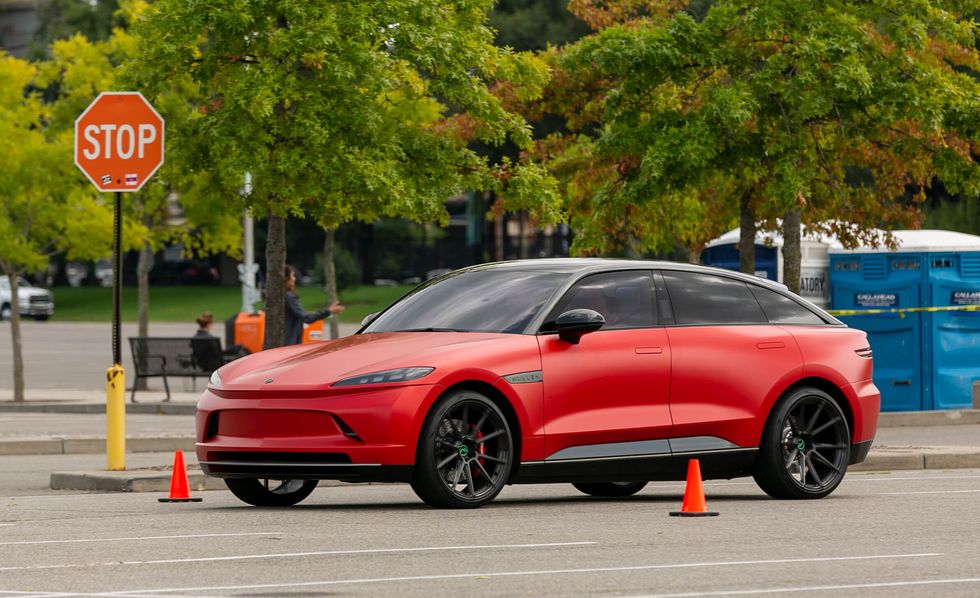- The Mullen GT is an electric sports car from a startup with roots in China.
- It claims a 60 mph time of 4.2 seconds and a top speed of 125 mph.
- The price is $150,000 and deliveries are said to start in 2025 or 2026.
Deep in Citi Field Lot E is an unidentifiable coupe under a green tent. Its low-slung body, cloaked in flat gray with a large black swoosh, is more concealing with every closing step. There’s a dragonfly emblem on the nose. A side swoosh is finished in exposed carbon and channels air to a pair of heat exchangers. The tail says Mullen. It’s the Mullen GT, an electric sports car from a startup that plans to start delivering cars in the U.S. in 2025 or 2026.
Like many automotive startups, Mullen’s backstory is complicated. It starts with the 2015 Shanghai debut of the Qiantu K50, an electric sports car that parent company Great Wall Huaguan would sell in China from 2018 until 2020. Later, at the 2019 New York Auto Show, a California company called Mullen Automotive pledged to import kits and sell finished, fully-certified examples in 2020. We’ve tracked many EV brands that have yet to sell a single car in the U.S., such as Bollinger, of which Mullen now owns a 60 percent stake. Mullen’s Nasdaq IPO was in November 2021 and it had a second reveal weeks later at the Los Angeles Auto Show, an SUV coupe called the Mullen Five.
Now, at this parking lot in Queens, we’re devoting an afternoon to Mullen’s elusive two-seater, the rebadged EV that Qiantu quit building three years ago. While Mullen was also prepping to build rebadged Chinese cargo vans and trucksin Mississippi, the K50 was using at least four names. Until last March, it was the Dragonfly K50, Mullen K50, Qiantu K50 by Mullen, or Mullen Dragonfly.
Next to us is Mitchell Dyche, an engineer whose six-foot-five frame comfortably fits in the cozy cabin. He says he specified the 19-inch center-lock wheels, Brembo brakes, and the Pirelli P Zero tires. The rest is Qiantu’s original vision, right down to the manufacturer etchings on the glass.
Up close, it looks good. Inside and out, the Mullen GT has the proportions and dimensions of a mid-engine car. It has about the same footprint as an Acura NSX. The body gaps could be tighter, but the GT is not the scrappy prototype we expected. There’s a large portrait touchscreen canted toward the driver that’s still under development, a digital instrument panel, and a large curved shifter. Unlike countless Chinese cars, the GT doesn’t overtly copy the design of any established brands. And while it’s a demonstrator, there’s noticeable polish.
The dual-motor setup is silent and devoid of whine, the regen is smooth, body motions are controlled, and the steering is pleasantly weighted. The specs are reasonable for a performance EV: About 400 horsepower packed into an aluminum frame with carbon body panels, all-wheel drive with torque vectoring, a 78.0-kWh T-shaped lithium-ion battery with the bulk of its cells behind the driver, and a claimed 230 miles of range. In Sport mode, the GT gets a little perkier, though in our three short laps we didn’t feel either motor shifting torque. Grip and stopping power are expectedly high.
But Mullen has downgraded the GT’s performance since March, when it promised an “EV supercar” that would accelerate to 60 mph in 1.95 seconds and exceed 200 mph. That’s when Mullen reacquired the rights to sell the K50 and settled a contract dispute, according to court documents, after it had allegedly defaulted on nearly $23 million owed to Qiantu just months after the New York reveal. Mullen has since walked back those supercar stats to 4.2 seconds and 125 mph. The price: $150,000.
Mullen has said it would build the GT (and a GTRS) at the old AM General plant in Indiana, where it also plans to build the Five crossover and Bollinger B1 and B2 (Bollinger had refunded customer deposits in 2022). Reservations are $1000 for delivery sometime in late 2025 or early 2026.
From an investor’s perspective, Nasdaq wants to delist Mullen stock for trading below the $1 limit (it’s below 50 cents as of Friday) and Mullen is concurrently suing some of the largest investment firms, including Charles Schwab, alleging manipulation of its stock. There’s a lot more about Mullen we won’t get into in great detail, including how the company was founded in 2014 after buying up the remains of Coda Automotive and then trying to resell that company’s Chinese rebadged EV as the Mullen 700e.
Objectively, given where it stands in 2023, the Mullen GT seems like a possibility but not a certainty. As more new automakers come to realize, building and selling cars to Americans is a very hard thing.
Contributing Editor
Clifford Atiyeh is a reporter and photographer for Car and Driver, specializing in business, government, and litigation news. He is president of the New England Motor Press Association and committed to saving both manuals and old Volvos.


